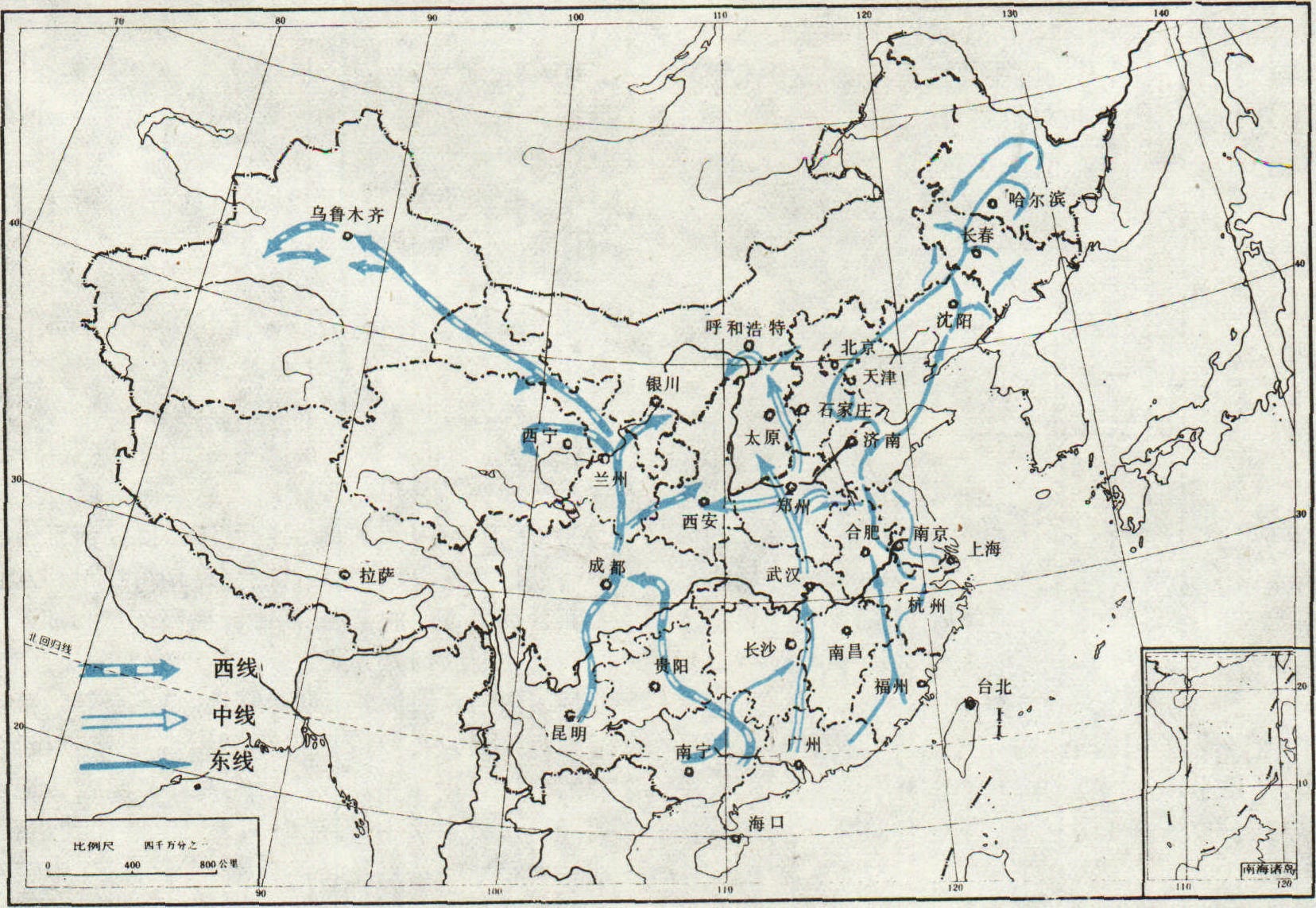转地养蜂migratory beekeeping
将蜂群运至距离较远、有大片蜜源植物流蜜的地方去获取蜂产品和进行繁殖的饲养方式。又称放蜂。为了给农作物授粉,制止盗蜂或预防中毒,有时也需将蜂群转地。转地饲养最早出现在埃及尼罗河流域,至今已有3000余年的历史。转地饲养可使蜂群提前繁殖,甚至不需进行渡夏或越冬,蜂群的生产期可提早和延长,便于充分利用各地的蜜源,使蜂群提高产量和加速发展,因而是主要的饲养方式之一。转地饲养分短途和长途两种。短途转地饲养又叫小转地,特点是转运范围小、运程近、中转少、费用省,有一两个主要蜜源和辅助蜜源的地区可以采用。长途转地饲养又叫大转地,一般要经一次或多次中转,历时两天以上才能到达新的场地。大转地的特点是转运范围大、运程远、中转多、适宜蜂群数量多、管理水平高、流动资金足、运输条件好的蜂场采用。
转地饲养的作业包括如下要点:
调查放蜂场地 良好的放蜂场地是转地饲养成功的关键。放蜂场地事先宜进行下列调查:❶蜜源植物的种类、面积、分布、长势、开花期、流蜜特点、农业技术措施、有无农药污染和有无有毒植物开花。
❷气象资料和水文资料,内容包括降雨日数、雨量、风向、风力、平均气温、最高或最低气温,空气湿度以及有无灾害性天气。
❸放蜂人员和蜜蜂所需要的水源、水质情况。
❹蜜蜂敌害种类、分布及危害程度。
❺放蜂场地附近其他蜂场的数量、饲养蜂群数、品种,和本场的距离。
❻可以利用的运输工具种类及承运能力。这些内容可进行实地调查或去信向放蜂场地所在地区有关单位了解。根据调查结果,制定放蜂路线计划;蜂群起运前应进行复查。放蜂场地情况如已发生变化,失去放蜂价值,应重新寻找新的放蜂场地。
中国长途放蜂路线 多个放蜂场地通过运蜂连接起来构成了放蜂路线。中国的长途放蜂路线主要有3条(见图): ❶东线:1~3月在福建、广东等地,利用油菜、紫云英蜜源进行繁殖。3~4月转运到江西、安徽、浙江采油菜、紫云英蜜源。4~5月在山东、河北采刺槐;6月采枣树。7月在辽宁、吉林、黑龙江采草木樨、荆条和椴树;8月采向日葵和苕条。8~9月到内蒙古、辽宁西部采荞麦。
❷中线:1~3月在广东、广西采油菜等蜜源并进行繁殖。3~4月转运到湖南、湖北采油菜、紫云英。5月到河南等地采刺槐。此后转运北京、山西、内蒙古等地,6~7月采油菜、百里香、荆条; 8~9月采向日葵、荞麦等蜜源。
❸西线:1~3月在云南、广西利用油菜等蜜源繁殖蜂群。3~4月转运到四川采油菜。油菜结束后再转运陕西、甘肃、宁夏、青海、内蒙古、新疆等省区,5~7月采油菜、狼牙刺、刺槐、苜蓿、草木樨,芸芥、老瓜头等蜜源; 8~9月采荞麦、野藿香和新疆的棉花等蜜源。采完上述东、中、西三条路线的最后一个蜜源,已到8~9月份,有的蜂场立即运回南方繁殖或越冬,有的蜂场在当地越冬到11~12月,然后直接运往南方繁殖场地,进入第2年的转地饲养。在按照上述三条主要路线放蜂时,有时中途也有穿插和交错,但基本的方向不变。
蜂群转运时间 根据季节、蜂群群势、生产要求、繁殖条件等因素,蜂群转运时间可先后推移。低温季节,从高纬度地带运往低纬度地带提前繁殖,一般安排在计划采蜜的第一个主要蜜源流蜜前两个月进场。在温暖季节,转地饲养的主要目的是追花夺蜜,赢得多种蜂产品的丰收,转运时间可按放弃原蜜源的末花期赶赴新蜜源的始花期的原则确定,也可根据天气变化略微提前或错后。
转地蜂群管理 管理工作应从该蜜源和以后衔接蜜源的特点考虑,以求达到三个目的:❶争取本花期蜂产品的丰收;
❷为采后期蜜源培育工作蜂或为越冬、渡夏培育适龄蜂;
❸减少以后运蜂的途中损失。长途转地饲养的蜂群,花前期和中期适当限制蜂王产卵,以减轻育儿负担,争取本花期丰收。限制蜂王产卵的程度由本蜜源和后期蜜源流蜜散粉的潜力和是否需要生产王浆及培育适龄越冬、渡夏蜂决定。蜜源进入花后期,应立即解除限制蜂王产卵措施,促进蜂王产卵,为下一蜜源培育较多的新蜂。(见运蜂)

中国长途放蜂路线图
中蜂群转地受到震动时,容易出现离脾现象。因此,转地运输的时间宜短,并尽量减轻震动和做好遮光、通风,以维持群内的安定。到达目的地后,为避免飞逃和迷巢,切勿立刻打开巢门,宜先向箱内喷水;蜜蜂安定后;再分批依次开放。当工蜂涌出巢门飞翔时,可用水向飞翔蜂喷雾。待全场蜂群恢复正常出勤之后,才能开箱检查。
转地养蜂migratory bee keeping
又称流动放蜂。将蜂群随不同地区蜜源植物的开花、流蜜期而连续迁移的养蜂方式。根据迁移路线的长短和迁场次数的多少,转地养蜂可分为大转地和小转地两种。大转地的迁移次数多、范围广、总距离可长达数百乃至上千千米;有的迁移次数虽不多,但距离可长达数百乃至上千千米。小转地则是蜂场相对固定在一定的范围内,随不同蜜源植物花期,仅作几次短途转移。